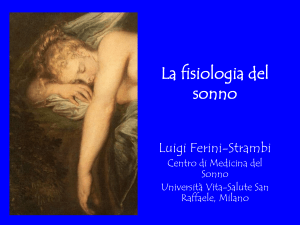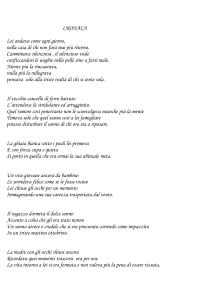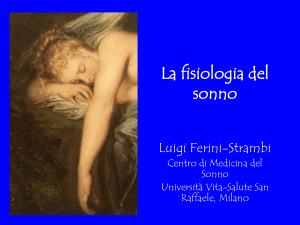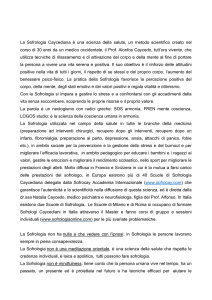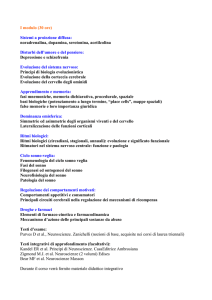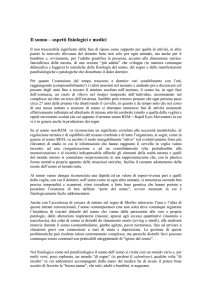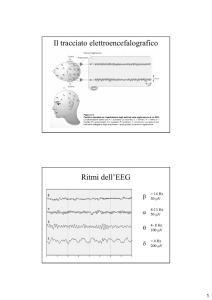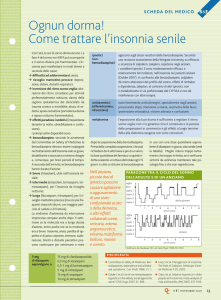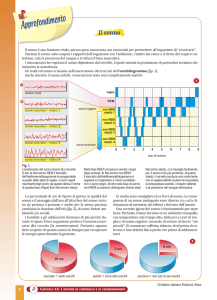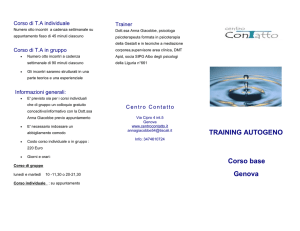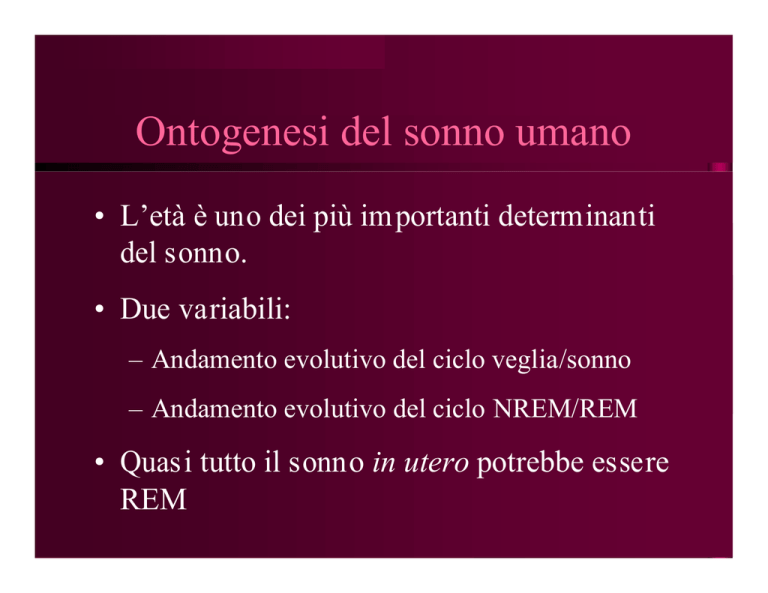
Ontogenesi del sonno umano
• L’età è uno dei più importanti determinanti
del sonno.
• Due variabili:
– Andamento evolutivo del ciclo veglia/sonno
– Andamento evolutivo del ciclo NREM/REM
• Quasi tutto il sonno in utero potrebbe essere
REM
Ontogenesi del sonno umano
• I neonati hanno una media di 16 ore di
sonno al giorno (range=11-21 h)
• Anche i neonati suddividono il loro sonno
in qualcosa di analogo al REM e NREM
• Il sonno REM è prevalentemente
caratterizzato da attività muscolari (REMs,
twitches, espressioni facciali)
Ontogenesi del sonno umano
• Il sonno NREM è più quieto, la respirazione
è più lenta e regolare, e la muscolatura più
rilassata
• Anche i bambini presentano cicli REM e
NREM
• Ogni ciclo di sonno dura, in media, circa 1
ora e, a differenza dell’adulto, inizia con il
sonno REM
Ontogenesi del sonno umano
• I genitori influenzano fortemente le
caratteristiche del sonno del bambino
sviluppando metodi e periodicità per la
veglia, l’alimentazione e il sonno.
Wake / Sleep Pattern Development
Development of the
wake / sleep pattern in
a human infant
Age Related Changes in DaySleep and Night-Sleep
Age
Sleep/hr
REM/hrs (%)
NREM/hrs (%)
Naissance
16
8.0
(50)
8.0 (50)
8 mois
13
4.3
(33)
8.7 (67)
EEG DA 2 a 12 Mesi
• maggiore differenziazione del periodo di veglia da quello
di sonno
• in sonno quieto (SWS), aumenta l ’ampiezza delle onde
delta e la frequenza raggiunge anche 0.5 Hz (passaggio
da un ’attività corticale unilaterale a una bilaterale)
• fusi del sonno (12-14 Hz) di maggiore durata dell ’adulto
compaiono tra i 2 e i 6 mesi
• maturazione del sonno attivo (REM) : la quantità di
attività muscolare diminuisce con il progredire dell ’età
RAPP ORTI TRA EEG E SVILUPPO CEREBRAL E
• la maggiore quantità di sonno REM è probab ilmente spiegabile nei
termini maggiore precocità (nella maturazione) dei neuroni implicati
nel controllo di questa fase del sonno
• la riduzione dell ’attività muscolare corporea in sonno REM (attivo) è
dovuta alla maturazione del sistema inibitorio muscolare, proprio del
sonno REM
• l neuroni corticali svil uppano massive interconnessioni verso i 3 mesi
di vita ==> l ’aumento di ampiezza delle frequenze lente si manifesta
proprio dopo questa fase
• le connessioni cortico-talamiche maturano completamente nei primi
mesi ==> necessarie per la comparsa dei fusi del sonno
• In veglia = depolarizz azione
• In sonno quieto = iperpolarizzaz ione
==> neuroni corticotalamici
Sleep architecture
over the lifespan
In the elderly...
♦ Sleep and alertness complaints are more
frequent
♦ Waketimes and bedtimes are earlier
♦ Nighttime sleep episodes are shorter
♦ Daytime sleep episodes are more frequent
♦ Sleep is shallower (less slow-wave sleep, more
stage 1 sleep)
♦ Sleep is more fragmented (more wakefulness
during the sleep episode)
Sleep parameters (means and sd) for the young men (YM), the old men
(OM) and the old women (OW) groups
YM
OM
(n=13)
(n=17)
Total sleep (min)
409.8 (49.0) 333.0 (66.9)
Sleep latency (min)
15.0 (11.5) 20.1 (11.8)
Sleep efficiency (%) 93.2 (7.1)
78.9 (11.4)
Stage 1 (%)
3.5 (2.1)
8.9 (4.8)
Stage 2 (%)
54.8 (6.8)
70.5 (7.3)
Delta (%)
15.8 (7.2)
1.2 (1.7)
REM (%)
25.9 (4.3)
19.5 (7.2)
REM latency (min) 65.9 (23.9) 58.9 (35.0)
OW
(n=26)
365.3 (56.1)
20.0 (13.6)
83.1 (9.1)
7.7 (9.4)
68.5 (12.5)
4.6 (6.1)
19.2 (6.1)
54.5 (29.3)
ANOVA
p<0.003
n.s.
p<0.001
p<0.01
p<0.001
p<0.001
p<0.006
n.s.
13-15 anni
Veglia intra-sonno
Stadio 1
1.16%
3.79%
41-46 anni
6.51%
6.23%
Stadio 2
26.97%
Stadio 2
Stadio 3
22.89%
Stadio 3
Veglia intra-sonno
Stadio 1
Stadio 4
REM
Stadio 4
REM
43.93%
8.36%
2.91%
18.10%
53.11%
6.05%
60-69 anni
Veglia intra-sonno
10.61%
Stadio 1
22.18%
Stadio 2
Stadio 4
12.59%
1.19%
53.44%
REM
Number of Minutes of Wakefulness during Sleep
30
25
20
15
10
5
Twenties
Thirties
Forties
Number of Minutes of Deep Sleep
70
60
50
40
30
20
10
Twenties
Thirties
Forties
Understand the mechanisms underlying
age-related modifications of the sleepwake cycle
Regulation of the sleep-wake
cycle: Two-process model
Process S (homeostatic)
Sleep intensity (SWS,SWA)
⇑ with the number of hours of wakefulness
⇓ with the number of hours of sleep
Process C (circadian)
Signal from the circadian pacemaker (SCN,
mélatonin, temperature)
Deterioration of the sleep-wake cycle with
advancing age: what is wrong?
♦ Phase advance of the output signal from the circadian system?
♦ Difference in the phase angle between sleep and the circadian
signal?
♦ Reduction of the output signal from the circadian system?
♦ Sensitivity to an altered phase relationship between the output
signal from the circadian pacemaker and the sleep-wake cycle?
♦ Rigidity of the circadian system, reduced ability to phase shift?
♦ Modification of the homeostatic process?

